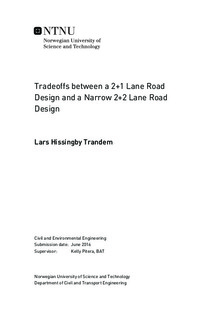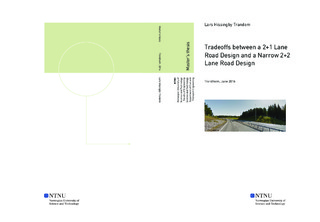| dc.description.abstract | This thesis examines whether you can achieve the same positive effect regarding traffic safety, while also increasing the capacity and level of service of the road by building a narrow 2+2 lane road instead of a 2+1 lane road, with minimal increase in construction costs. While the safety, costs and traffic operations aspects of the different road designs are the most important to evaluate, the non-monetized impacts like landscape, local surroundings and outdoor activities, biodiversity, cultural heritage and natural resources are also considered, as is standard in Norwegian consequence analysis methodology.
An extensive literature review was carried out for evaluating different aspects of the 2+1 lane road design and the narrow 2+2 lane road design regarding design, safety, capacity and level of service, monetized impacts and non-monetized impacts. In addition, the methods in Highway Capacity Manual are applied for calculation and evaluation of the level of service, and the program EFFEKT is used to estimate the monetized impacts, in connection with a case study of a project in Norway where a narrow 2+2 lane road configuration has been used.
The overall impression is that the 2+1 lane road design has a slight advantage over the narrow 2+2 lane road design regarding traffic safety because of wider lanes and shoulders, assumed lower mean speed and possibly less rutting. The size of the presumed safety advantage is not possible to quantify from the content of this thesis.
Based on the findings presented in this thesis the capacity and level of service provided by the narrow 2+2 lane road design is higher than what the 2+1 lane road design can offer. Whether the higher capacity and level of service make the narrow 2+2 lane road design more economical beneficial than the 2+1 lane road design seems to depend on the expected amount of traffic. As long as the average travel speed for the 2+1 lane road was not significantly lower than for the narrow 2+2 lane road, the 2+1 lane road design scored the highest benefit-cost ratio for the case scenarios. When it comes to the non-monetized impacts it seems to be so small differences between the two designs that there is no basis to distinguish them. Other elements like location of the road and route alignment are more likely to have a bigger impact when less than two meters separates the cross section widths. | |

